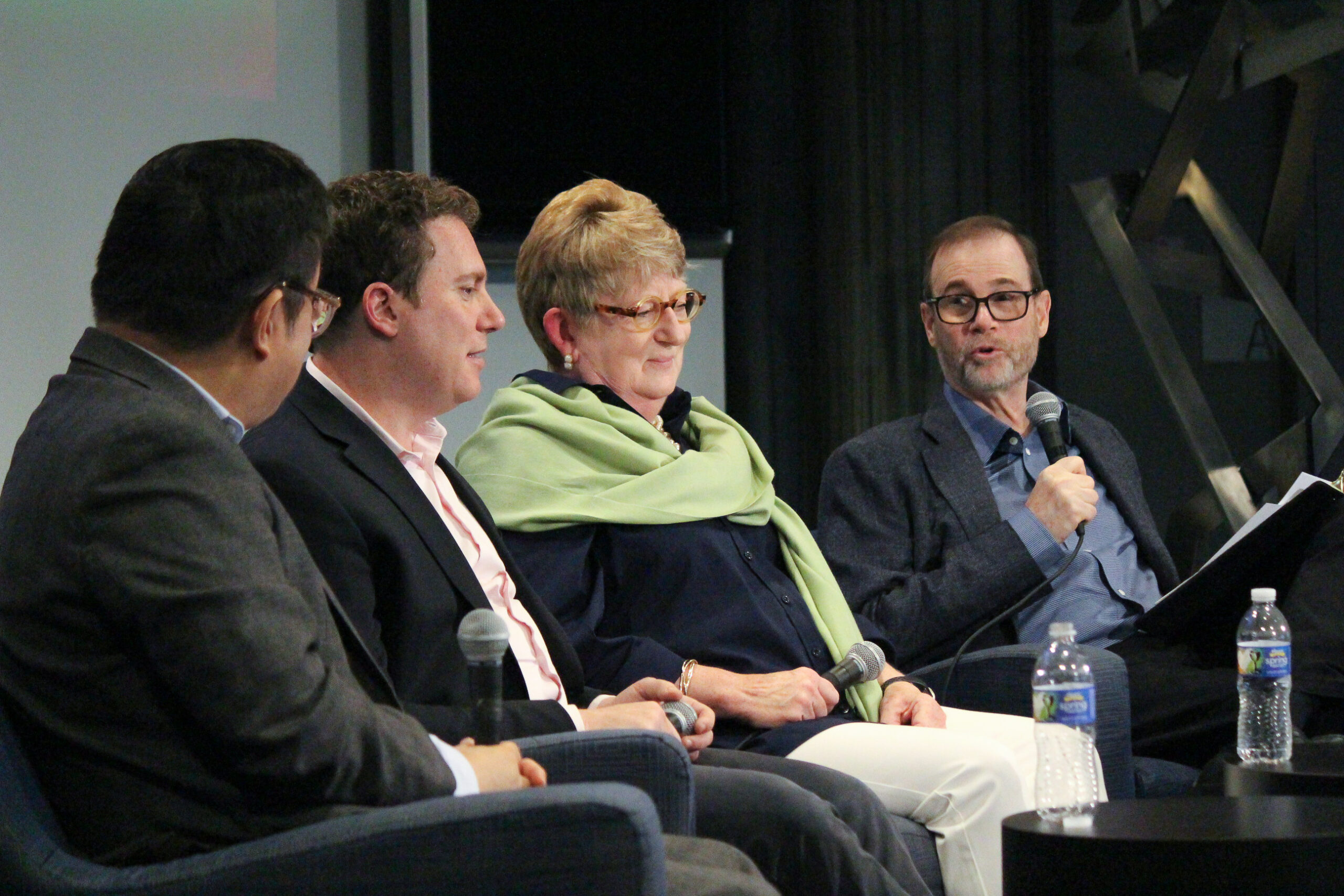Watch the Video Recap:
Event Date: Sept. 18, 2024
Our Panelists:
- Kathleen Carroll, Board Chair, Committee to Protect Journalists (2017-2023); Executive Editor, Associated Press (2002-2016)
- Sewell Chan, Executive Editor, Columbia Journalism Review; Editor-in-Chief, Texas Tribune (2021-2024)
- Ben Smith, Editor-in-Chief, Semafor; Editor-in-Chief, Buzzfeed News (2011-2020)
Moderator: Stephen J. Adler, Director, Ethics & Journalism Initiative; Editor-in-Chief, Reuters (2011-2021)
The Question
In the summer of 2024, reporters from several publications received emails offering access to internal Trump presidential campaign documents, including a dossier that was prepared to identify potential vulnerabilities of J.D. Vance before he was selected as Trump’s running mate. The campaign had allegedly been hacked by agents of Iran.
What’s a journalist to do?
Under what circumstances, if any, is it ethical for journalists to publish information from hacked files, especially during an election race, and to what extent are the hackers’ motivations relevant to the question?
The EJI Takeaways
When First Contacted by Anonymous Sources, Dig Deeper
Moderator and Ethics & Journalism Initiative Director Stephen Adler began the session by asking panelists how they would respond to the circumstances of the summer’s events. The panelists agreed that the origin of the documents is relevant to the story, and, in some circumstances, may even be the crux of the story. “You have to negotiate” with the source, said Kathleen Carroll, and try to get details about where the document is coming from and why it is being leaked. In addition, she said, “Use [the outreach] as a springboard,” for additional verifying questions: “What do we know about it? Is it true? What’s the value of the information that’s in the files? Is it something that we need to know? Is it something that readers need to know?”
These questions are even more important in the current “age of big data,” added Sewell Chan, as leaks have broadened from just individual documents to terabytes of data. Pursuing additional information about anonymous sources and documents of unknown origin helps journalists be more transparent with their readers and avoid merely being manipulated. Adler noted that a reporter can decline to promise anonymity to a source or refuse to accept a document from a source who won’t be identified, if the identity of the source is important to the story.
Consider Source Motives — But Don’t Be Deterred By Them
Once you dig deeper into a source’s potential motives, should what you find influence your decision to publish? “Source motivations have always mattered,” Chan told the session. “Every source has a motivation.” And once you have more clarity around source motivations, they can be hard to ignore.
Our panelists largely agreed that source motivation should be a consideration when deciding whether or not to publish potentially hacked materials, but not a deciding factor. “There’s no clear line,” Carroll sait. “You need to be aware of motives but there’s not necessarily an automatic yes or no answer when you find out what the motive is.”
During the event Q&A period, Jacob Weisberg, current Board Chair of the Committee to Protect Journalists and CEO of Pushkin Industries, asked panelists whether their decisions would be affected if they learned that a source has potential ties to foreign adversaries, as in the case of Iran’s alleged hack of the Trump campaign. Weisberg advised greater caution within a “hostile power with an intent to influence an election.” Panelist Ben Smith, however, said he would scrutinize the Iranian government’s potential motivations and interests within the same “spectrum” as he would any other source. Smith emphasized that while “there’s an underlying sense that we’re supposed to be patriotic to our country and not encourage foreign intelligence attacks on it,” subjective assessments of the relative threats of different foreign governments – and the U.S. government for that matter – may compromise journalists’ larger social obligation to publish. “I get nervous when you start coming up with excuses not to publish stuff,” Smith said, such as if “you have people in newsrooms sitting around saying, ‘Our duty as patriots is to keep secrets.’” Still, the panelists agreed that reporting on the fact that the information may have originated from a hack by a foreign government was necessary to tell the complete story.
When Deciding Whether to Publish, Favor Principles Over Hard-and-Fast Rules
Weisberg and Margaret Sullivan, Executive Director of the Craig Newmark Center for Journalism Ethics and Security at Columbia University, called on the journalism community to create “neutral principles that can be applied across episodes,” citing inconsistency in how the news media covered the 2014 Sony Pictures Hack, 2016 leak of Hillary Clinton emails, and the recent Trump documents. Sullivan, also a weekly columnist for the Guardian US, pushed panelists further to boil down the “ethics takeaway” for early-career journalists and news leaders.
Adler laid out the position that newsworthiness and public interest should be paramount. “Publish information that is newsworthy, of interest and importance to the public, and put it in the context as transparently as you can of where it came from. If it’s newsworthy, I’d publish it even if I didn’t like the source,” particularly during an election period. With regard to the recent Trump materials, Chan suggested that the public would likely have been “better served if we knew a bit more about the documents.”
Smith advocated for an “incredibly strong presumption toward publishing,” as part of journalists’ core social function to produce information, while Carroll added that information should also be verifiable to prevent the spread of misinformation. Clear principles, Weisberg emphasized, are essential to “preserving the press discretion” to make publishing decisions independently, a cornerstone of press freedom.
Learn from Past Mistakes
A key aspect of creating principles for the future is learning from the past. Carroll, who was Executive Editor of the Associated Press during the leak of emails between presidential candidateHillary Clinton and her campaign chair, John Podesta, that were made public after a Russian hack in 2016, says she’s now “struck by how small so many of the stories” were that news outlets chose to publish, many of which she’s doubtful would run today. Smith recalled his decision to publish significant coverage of the leak itself when he was at the helm of Buzzfeed News, after concluding that “the Russian hack [was] the bigger story than anything in these emails.”
Newsrooms’ decisions not to publish the Trump documents this summer, Smith suggested, may be a direct result of media reflection on the issues with 2016 coverage. “There’s incredible irony; Donald Trump revels in, welcomes, invites [the 2016] hacking, benefits from it, and now is benefiting from all the lessons we learned at Hillary Clinton’s expense,” Smith said. Chan concurred: “Media has evolved. Media criticism evolves. There’s this greater level of mindfulness and conscientiousness” than in 2016.
Contextualize Your Decision for Your Audience, Whether You Publish or Not
While newsrooms – and newsroom leaders – may disagree as to whether or not to publish hacked materials, our panelists agreed that they have an ethical mandate to be transparent with their audiences about how they reached their decision.
If journalists do decide to publish documents from anonymous sources, they should be clear about what the documents have to offer to audiences. Looking back on his 2017 decision as Buzzfeed News editor-in-chief to publish the Steele dossier, a political opposition research report with extensive claims about alleged collusion by Donald Trumpwith the Russian government, Smith reflected that his team could have done more to communicate to audiences that the claims in the dossier were unverified. “We published the [Steele Dossier] in a PDF with a link to the article about how it was unverified. But then the PDF takes on a life of its own,” he said. Contextualizing information is even more important – and more challenging – as more audiences increasingly favor direct sources over media analysis, Chan added: “We’re in an era where people are eager to skip past the gatekeepers, the mediators, the explainers and go straight to the source.”
It was the consensus of the group that the same standards of clarity and transparency should also apply when a newsroom decides not to publish, particularly if it is already known that the newsroom has documents in their possession. Adler cited data journalists as leading the way in terms of transparency and advised attendees to take inspiration from data journalists’ granular explanations of their processes. “Whatever decision you arrive at, readers are not seeing this decision in a vacuum,” Chan advised, citing skepticism of the news media from readers from across the political spectrum. Being transparent can ward off conspiracy theories and rebuild audience trust, Carroll said. “Putting your processes out in front of the readers helps them understand your thinking and will diminish slightly the prospect of them imagining what your thinking is.”


